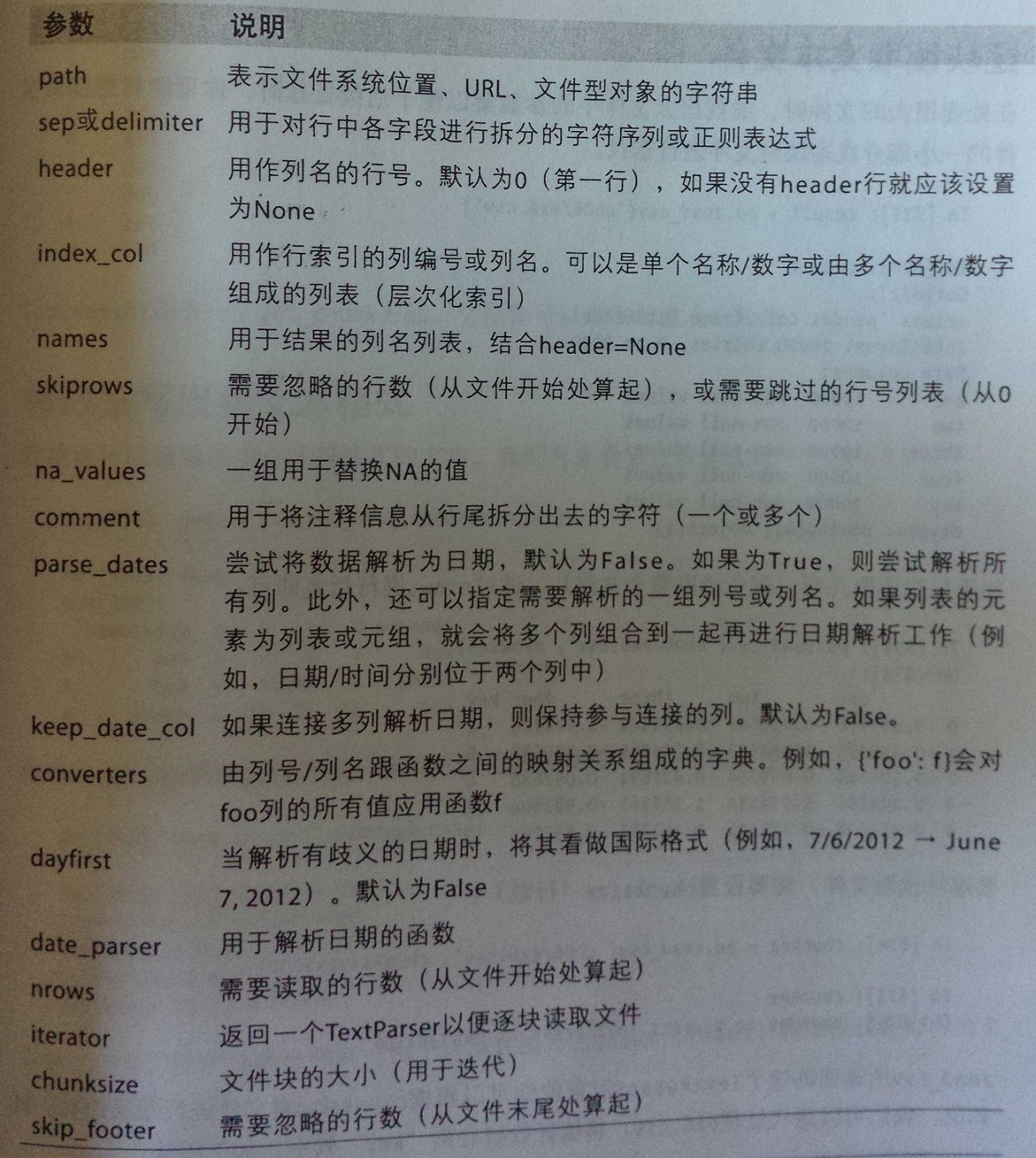一:CSV数据
一】:导入数据
1)从CSV文件读入数据:pd.read_csv("文件名"),默认以逗号为分隔符
D:dataex1.csv文件内容: D:dataex2.csv文件内容
a,b,c,d,message 1,2,3,4,hello
1,2,3,4,hello 5,6,7,8,world
5,6,7,8,world 9,10,11,12,foo
9,10,11,12,foo
1 In [3]: df1 = pd.read_csv('D:dataex1.csv') #打开后默认添加index为从0自增长,columns默认用第一行数据 2 3 In [4]: df1 4 Out[4]: 5 a b c d message 6 0 1 2 3 4 hello 7 1 5 6 7 8 world 8 2 9 10 11 12 foo 9 10 In [15]: df2 = pd.read_csv('D:dataex2.csv') 12 In [16]: df2 13 Out[16]: 14 1 2 3 4 hello 15 0 5 6 7 8 world 16 1 9 10 11 12 foo 17 18 In [17]: df2 = pd.read_csv('D:dataex2.csv',header=None) #header参数指定columns都为从0自增长的数 20 In [18]: df2 21 Out[18]: 22 0 1 2 3 4 23 0 1 2 3 4 hello 24 1 5 6 7 8 world 25 2 9 10 11 12 foo 26 27 In [8]: df2 = pd.read_csv('D:dataex2.csv',names=list('abcde')) #用names参数指定columns的值 29 In [9]: df2 30 Out[9]: 31 a b c d e 32 0 1 2 3 4 hello 33 1 5 6 7 8 world 34 2 9 10 11 12 foo 35 36 In [13]: df2 = pd.read_csv('D:dataex2.csv',names=list('abcde'),index_col='e') #用index_col用指定的columns首元素作为index 38 In [14]: df2 39 Out[14]: 40 a b c d 41 e 42 hello 1 2 3 4 43 world 5 6 7 8 44 foo 9 10 11 12
2)其他格式:pd.read_table('文件名', sep='划分依据'),划分依据可用正则表达式【s:空格等不可见字符】
注:read_table方法几乎可以读所有的表格型数据,包括txt,csv等等
D:dataex3.txt D:dataex4.txt
A B C D A B C
aaa -0.2 -1.02 -0.62 aaa -0.2 -1.02 -0.62
bbb 0.93 0.3 -0.03 bbb 0.93 0.3 -0.03
ccc -0.26 -0.39 -0.22 ccc -0.26 -0.39 -0.22
ddd -0.87 -0.35 1.1 ddd -0.87 -0.35 1.1
1 In [37]: df1 = pd.read_table('D:dataex3.txt',sep='s+') 3 In [38]: df1 4 Out[38]: 5 A B C #以最小列数为准,取dataframe数据,且第一行数据作为columns,剩下的如果第一列作为多出则作为index,否者从0自增数作为index 6 aaa -0.20 -1.02 -0.62 7 bbb 0.93 0.30 -0.03 8 ccc -0.26 -0.39 -0.22 9 ddd -0.87 -0.35 1.10 10 11 In [44]: df2 = pd.read_table('D:dataex4.txt',sep='s+') 13 In [45]: df2 14 Out[45]: 15 D A B C 16 0 aaa -0.20 -1.02 -0.62 17 1 bbb 0.93 0.30 -0.03 18 2 ccc -0.26 -0.39 -0.22 19 3 ddd -0.87 -0.35 1.10
3)扩展技巧
read_csv/read_table函数参数


D:dataex5.csv D:dataex6.csv
#hey! something,a,b,c,d,message
a,b,c,d,message one,1,2,3,4,NA
#just wanted to make things two,5,6,,8,world
#who are you three,9,10,11,12,foo
1,2,3,4,hello
5,6,7,8,world
9,10,11,12,foo
1 In [46]: df5 = pd.read_csv('D:dataex5.csv') 3 In [47]: df5 4 Out[47]: 5 #hey! 6 a b c d message 7 #just wanted to make things NaN NaN NaN NaN 8 #who are you NaN NaN NaN NaN 9 1 2 3 4 hello 10 5 6 7 8 world 11 9 10 11 12 foo 12 13 In [48]: df5 = pd.read_csv('D:dataex5.csv',skiprows=[0,2,3]) 15 In [49]: df5 16 Out[49]: 17 a b c d message 18 0 1 2 3 4 hello 19 1 5 6 7 8 world 20 2 9 10 11 12 foo 21 22 23 In [59]: df5 = pd.read_csv('D:dataex6.csv',nrows = 2) 25 In [60]: df5 26 Out[60]: 27 something a b c d message 28 0 one 1 2 3 4 NaN 29 1 two 5 6 NaN 8 world 30 31 In [55]: df6 = pd.read_csv('D:dataex6.csv',na_values={'message':['foo','NA'],'something':['two']}) 33 In [56]: df6 34 Out[56]: 35 something a b c d message 36 0 one 1 2 3 4 NaN 37 1 NaN 5 6 NaN 8 world 38 2 three 9 10 11 12 NaN
二】 数据的写出:to_csv('文件名' , [index=..., header=...] )
1 In [7]: df = pd.read_csv('D:dataex1.csv',header=None) 2 3 In [8]: df 4 Out[8]: 5 0 1 2 3 4 6 0 a b c d message 7 1 1 2 3 4 hello 8 2 5 6 7 8 world 9 3 9 10 11 12 foo 10 11 In[9]:df.to_csv('D:dataout1.csv') 12 13 In[10]:df.to_csv('D:dataout2.csv',index=False,header=False) #即是把index和columns都弃掉,header表示columns
二:JSON格式
Json类型基本数据类型有对象(字典),数组(列表),字符串,数值,bool 以及 null。
注:若是字典,键的类型必须是string
In [22]: js = """{ ....: "name":"Wes", ....: "places_lived":["US","Spain","Germany"], ....: "pet":null, ....: "siblings":[{"name":"Scott","age":25,"pet":"Zuko"}, ....: {"name":"Katie","age":33,"pet":"Cisco"}]} ....: """ In [26]: import json In [27]: data = json.loads(js) #将json格式转化为python格式 In [28]: data Out[28]: {u'name': u'Wes', u'pet': None, u'places_lived': [u'US', u'Spain', u'Germany'], u'siblings': [{u'age': 25, u'name': u'Scott', u'pet': u'Zuko'}, {u'age': 33, u'name': u'Katie', u'pet': u'Cisco'}]} In [29]: #a_js = json.dumps(data) #将python格式转化为json格式 #最简单构造方法就是提取其中的数据,注意columns list中的值对应json数据中的需要提取的键并将其作为columns In [31]: siblings = pd.DataFrame(data['siblings'],columns=['name','age']) In [32]: siblings Out[32]: name age 0 Scott 25 1 Katie 33
三:XML与HTML
pass
四:二进制 179
pass
五:Excel 180
pass
七:HTML 与 Web API 181
许多网站提供基于json格式的数据API,通过request等库可以获取
pass
六:数据库 182
pass
七:MongDB
184